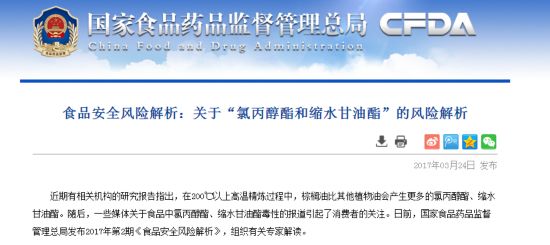Palm oil contains poison and can’t be eaten more? The General Administration of Food and Drug Administration said this
Recently, the research report of relevant institutions pointed out that palm oil will produce more chloropropanol esters and glycidyl esters than other vegetable oils in the process of high-temperature refining above 200℃. Subsequently, some media reports about the toxicity of chloropropanol ester and glycidyl ester in food attracted consumers’ attention. A few days ago, china food and drug administration released the second issue of Food Safety Risk Analysis in 2017, and organized relevant experts to interpret it.

Chloropropanol ester is the esterification product of chloropropanol compounds and fatty acids, which can be divided into 3- chloropropanol ester (3-MCPD ester), 2- chloro -1,3- propanediol ester (2-MCPD ester), 1,3- dichloro -2- propanol ester (1,3-DCP ester) and 2,3- dichloro according to the different types of chloropropanol. In recent years, it has been found that 3- chloropropanol esters are detected in cereals, coffee, fish, meat products, potatoes, nuts and hot-processed fatty foods with vegetable oil as raw materials. Especially, the reports of detecting 3- chloropropanol ester in refined vegetable oil and other foods are increasing gradually. Glycidyl ester is the esterification product of fatty acid and glycidyl ester. It is a twin brother with chloropropanol ester, and its formation mechanism is similar. In the process of oil refining, glycidyl ester is usually formed together with 3- chloropropanol ester, and the content of 3- chloropropanol ester is high, so is the content of glycidyl ester. 3- chloropropanol ester and glycidyl ester have become the new pollutants of vegetable oil that attract worldwide attention.
Second, some studies believe that these two substances have a low risk of harm to human health.
At present, the toxicological research on 3- chloropropanol ester and glycidyl ester is not systematic. The Hong Kong Centre for Food Safety assessed the exposure of people according to the content of 3- chloropropanol esters in biscuits, vegetable oils, cakes and other foods, and concluded that the health risks of 3- chloropropanol esters ingested through the above foods did not need special attention. The German Institute for Risk Assessment assessed the risk of glycidyl ester intake by European people through vegetable oil, and concluded that glycidyl ester intake by the general population through vegetable oil does not pose a safety risk to health. At present, the published research data in China also believe that the risk of glycidyl ester intake by the general population through food such as vegetable oil is low.
3. At present, there is no international limit standard for these two substances.
3- chloropropanol ester may be hydrolyzed into 3- chloropropanol in vivo. In 2012, the Joint Expert Committee of Food Additives of the Food and Agriculture Organization of the United Nations (FAO)/ World Health Organization (WHO) formulated the tentative maximum daily tolerance (PMTDI) of 3- chloropropanol as 2μg/kg per kg body weight. However, the corresponding limit standards for 3- chloropropanol ester and glycidyl ester have not yet been formulated.
Fourthly, optimizing the refining process can reduce the content of these two substances.
The results show that the content of 3- chloropropanol ester in oil processing raw materials and unrefined vegetable oil is extremely low, but the content of refined vegetable oil increases significantly, and its content level is related to the types of raw materials of crude oil. Compared with corn oil, rapeseed oil and soybean oil, vegetable oil with pulp as raw material, such as palm oil, is more likely to produce 3- chloropropanol ester. Optimizing the production process can reduce and control the production of 3- chloropropanol ester and glycidyl ester in vegetable oil refining.
Therefore, experts suggest: First, strengthen analysis and research to provide scientific basis for whether it is necessary to formulate limit standards for these two substances. Second, according to the characteristics of different oil raw materials, for example, some oils are suitable for cold pressing and some are suitable for hot processing, and different processing methods are established. Moderate processing can reduce the formation of harmful substances and avoid the excessive formation of various risk factors. Third, consumers should pay attention to nutrition collocation and food diversification in their daily diet, and take vegetable oil according to the dietary guidelines of China residents (2016) to avoid excessive intake.